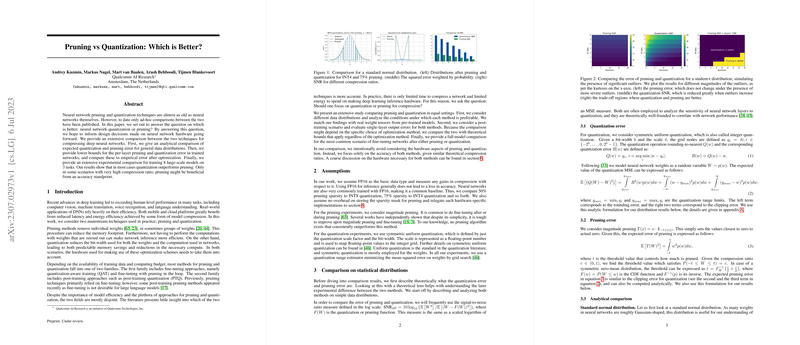A Comparative Analysis of Pruning and Quantization in Neural Network Compression
The paper "Pruning vs Quantization: Which is Better?" provides a detailed inquiry into the efficiencies of pruning and quantization techniques in compressing deep neural networks (DNNs). The authors aim to delineate which of these methods proves more effective, focusing on their potential impact on neural network accuracy.
Analytical Comparisons
The paper begins with an analytical exploration of both techniques. Quantization, which reduces the bit-width for weights and computations, generally provides predictable memory savings and computational reductions. Conversely, pruning eliminates certain weights, thereby affecting both the memory footprint and computational load during inference.
Using signal-to-noise ratio (SNR) as a key metric, the authors analyze the mean-squared error (MSE) introduced by each method. This analytical framework provides a theoretical basis for understanding the underlying trade-offs. The results of these analyses suggest that quantization possesses a superior SNR in moderate compression scenarios, particularly when weights are Gaussian-like.
Experimental Evaluations
The paper extends to empirical evaluations using real data from pre-trained models across various scales. A notable finding across these models is that quantization outpaces pruning in scenarios except those involving extreme compression ratios. Here, pruning might be preferable due to its distinct handling of distribution tails but at a cost to model performance, which is often prohibitive.
Post-Training and Fine-Tuning Scenarios
In post-training conditions, the paper leverages theoretical bounds, using semi-definite programming (SDP) to assess quantization errors and exact solutions for pruning in manageable scenarios. This methodology avoids biases inherent to specific optimization algorithms and offers a clearer picture of the potential effectiveness of both techniques.
Under fine-tuning conditions, the quantization-aware training (QAT) method LSQ consistently outperformed pruning methods in maintaining model accuracy across various tasks, even under equal compression ratios. Pruning primarily serves well at extremely low bit-widths, which are not typically operational due to significant accuracy drops.
Implications and Future Directions
Practically, the findings advocate for prioritizing quantization in neural network deployments where computational efficiency and accuracy are paramount. The potential of intrinsic sparsity in quantized tensors suggests additional avenues for optimization without complicating hardware requirements.
The paper hints at future areas of research, including exploring combinations of pruning and quantization. Despite the potential theoretical advantages of these combinations, further practical investigations are required to assess their feasibility and impact across diverse models and architectures.
Conclusion
This research presents a comprehensive comparison between pruning and quantization, illustrating the consistent edge that quantization holds in most practical compression scenarios. The emphasis on accurate SNR assessments and the dual focus on both theoretical and empirical analyses significantly contribute to its usefulness for hardware-aware model compression strategies. Without focusing on the hardware specifics intensely, the paper provides essential insights for researchers and practitioners looking to optimize neural network performance efficiently.
